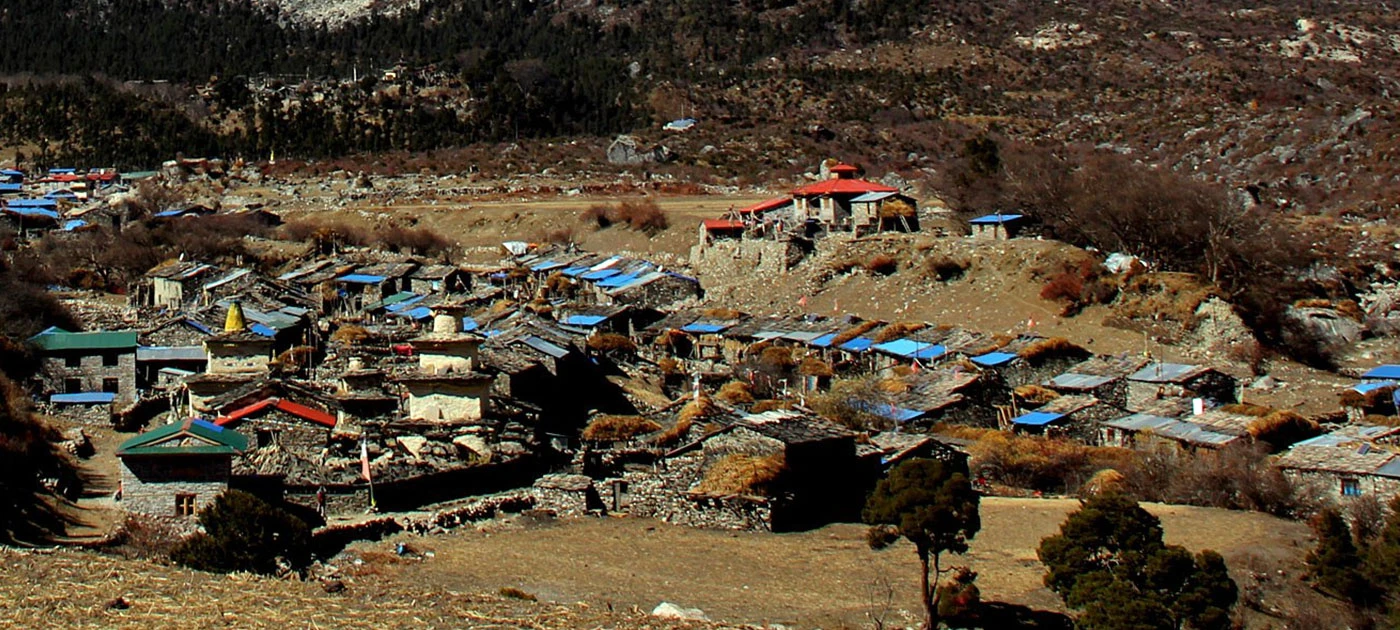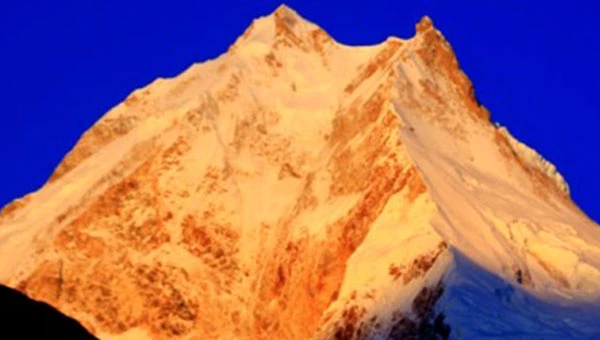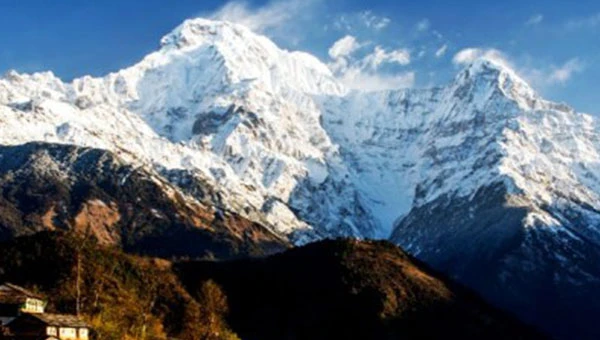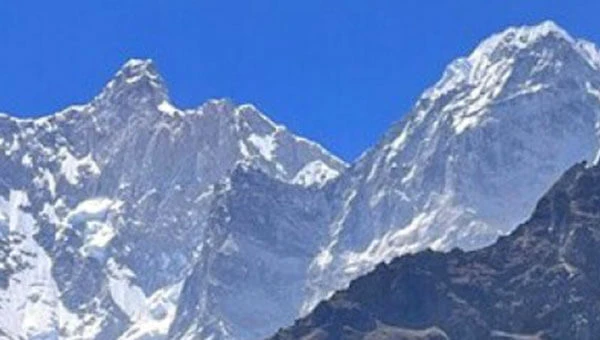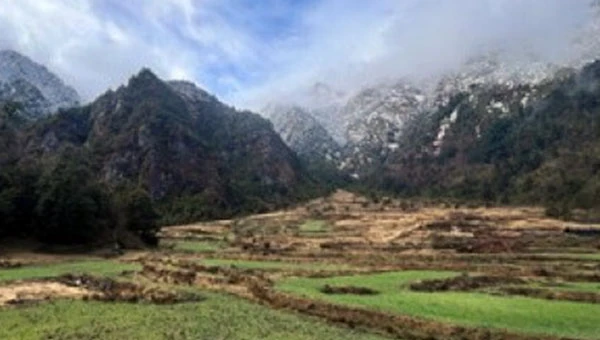Scenery and wildlife
Without a doubt, the Manaslu Trek leads to the magical scenery of nature, which is not much disturbed or spoiled. From the lowlands, hills, and ridges to the world's 8th highest mountain view, trekkers experience the range of landscape along with the diverse flora and fauna preserved by Manaslu and Annapurna Conservation Area. The trails run through these two conservation areas, sharing the remarkable scenery and walk. The jaw-dropping view and encounter of wildlife cheer up trekkers to have a hard climb.
Even the snowcapped mountains are closely viewed, namely, Manaslu, Nagadi Chuli, Himalchuli (7,893 m or 25,896 ft), Ngadi Chuli (7,871 m or 25,823 ft), Shringi (7,187 m or 23,579 ft), Langpo (6,668 m or 21,877 ft), and Saula (6,235 m or 20,456 ft).
Tibetan-influenced Culture
The local lifestyle, traditions, and culture of people living in the Manaslu region are highly influenced by Tibetan culture. The border of Tibet is too close, and the influence is widely visible. Especially, Tsum Valley showcases and preserves the authentic Tibetan culture, religion, and traditions, which have forced the Government to impose special permits in order to limit tourism and preserve the authenticity of Tsum Valley. Trekkers could observe monasteries, sacred caves, Chortens, mani walls, and prayer flags.
The rich cultural heritage is evident in several large Buddhist monasteries like Shringi Gompa in Bihi, Mu Gompa (the largest monastery of the Manaslu area), Panago Gompa, Mani Dhungyur, Gurwa Gompa, Rachen Gompas, Dephyudonma, and Rachen Gompa. Lokpa village is believed to have been blessed by Padmashamva centuries ago. The famous Tibetan saint named Milarepa was believed to have meditated in the Piren Phu cave.
These sites have been abundantly painted with Buddhist murals, excellent artistic scripts carved on the stones, long prayer flags, and Buddhist paper scripts. Spin prayer wheels in a clockwise direction, walk left to the sacredness of structures, use two hands for donation, and greet people with the word “Tashi Delek,” which Tashi = auspicious, and Delek Blessing/ Goodluck.
Best Season for Manaslu Trek
Spring (March-May) and Autumn Season (September-November) are regarded to be the best for Trekking in Nepal on any of the trekking trails. Though Monsoon (June-August) and Winter (December-February) Seasons do supply pleasant views and experiences, trekkers feel uneasy trekking during the rain and snow.
Spring Season is neither hot nor cold, as summer is about to begin, winter ends. Vegetation starts to bloom and upgrades itself into a colorful texture. The clouds are swept away, leaving the clear, bright, bluish sky and mighty silver mountains with dry paths without snow and rain.
Similarly, Autumn welcomes winter and sees off the summer, and spreads yellow and orange colors into the green lush vegetation. The Autumn season makes the mountain shine brighter and the sky flaunts clearer. These seasons are extensively preferred and loved by trekkers who make the trail busy.
Rain pours extensively during monsoon; flora bloom to the fullest, the clouds and mountains play hide and seek, and trekkers long for the clear day and views. Whereas, the Winter season brings a clear sky and mountain view with short days, snowy paths, and the quietest villages (People of higher altitudes shift to a lower altitude for winter). These seasons make trails wet and slippery.
Must not travel alone on the Manaslu Trek
Manaslu Trek is exclusive with fewer trekkers and more restrictions. It consists of various permit requirements (details of the permit: How to get the Manaslu Trek permit?) as per the trekking route. The inclusion of permits and wilderness makes the area quiet and deserted.
Besides, Nepal Government restricts trekkers from traveling alone in the Manaslu Trek and must be led by a guide. Likewise, while trekking to a higher altitude and into a calm nature, it is better to have company as one may face any emergency as Altitude sickness, wildlife encounters, landslides, and avalanches. Therefore, trekkers must not travel alone on the Manaslu Trek.
Accommodation in Manaslu Trek
Accommodation in the Manaslu Trek consists of small teahouse lodges with basic amenities. Trekkers stay at available teahouse lodges on a sharing basis as per the package booked. Trekkers will be sharing rooms with other trekkers who hired the same company for the Manaslu trek. A Tea House lodge is a combination of a guest house, restaurant, and hall, which varies as per the village. The rooms have twin beds, blankets, and little additional furniture like small tables or chairs. Bathrooms are common with squatting toilets or western commode toilets. Tea house lodges have hot shower facilities with extra charges (excluded from packages).
Food and Water in Manaslu Trek
Manaslu Trek has teahouse lodges serving cuisines but with a Nepali twist. The menu throughout the trial is similar, including Continental, Indian, Nepali, and Tibetan dishes such as Tibetan bread, toast omelet, eggs, Dal–Bhat (rice, lentils, vegetable curry), fried noodles, noodles soup, Chowmein, potatoes, momo, soups, pizza, pasta, spaghetti, fries. Cheese and some of the vegetables prepared are locally produced. But you should not expect it to be as fancy as the restaurants in the town. Soft drinks, snacks, energy bars,s, and beer are also available.
Smoking and drinking alcoholic beverages are not recommended for travelers throughout the trek as it hardens their bodies to cope with high elevation. Interested travelers can drink and smoke while returning to a lower elevation.
You should be careful about your consumption of water in terms of both quality and quantity. You need to stay hydrated, and half a liter of water every hour should be enough during the Manaslu Trek.
Spring or tap water is available, which is directly drunk by locals. But, we do not recommend you do so, as locals and your body mechanics are different due to the environment and surroundings. Drinking water options:
- Packaged Drinking water is widely available, which also increases the litter in the areas and the areas that do not carry any recycling operation. So, packaged water is less recommended by us.
- Boiled water is available for purchase in different teahouses/ lodges.
- Use purification tablets/ iodine/ chlorine.
Usually, experienced trekkers add flavored drink powder or vitamin C tablets to their bottles to add taste and extra nutrition. Carrying Two Reusable water bottles is recommended for the Manaslu Trek.
Options of Manaslu Trekking Trail and Days Required
Manaslu Trek is untouched and has only 4 packages. However, you can combine or customize these packages and itineraries as per your requirement under the guidance of the trekking company. The options for the Manaslu Trek, as per the days required, are:
- Manaslu Circuit Trek 15 Days
- Short Manaslu Circuit Trek 10 Days
- Manaslu Tsum Valley Trek 17 Days
- Manaslu Tsum Valley and Larke Pass Trek 21 Days
During the Manaslu Trek, make sure you visit the amazing side sites such as Pungent Monastery, Samagaun, Birendra Lace, Manaslu Base Camp, and Rui La base point (Tibet Border). You can also check the blog: How many days for the Manaslu Trek?
Recommended to Pre-book Manaslu Trek Packages
Manaslu Trek demands many legal documents and permits, with limited capacity to serve the trekkers. Additionally, Nepal Government has strictly made rules of a minimum of 2 trekkers in a group, and the group must be led by a guide. Therefore, it is easier, more convenient, and more efficient to pre-book your favorite Manaslu Trek packages from a legally registered trekking company like Nepal Adventure Team. The freelancing guide is not allowed to apply for a permit. Per-booking of packages includes necessary meals, accommodation, and transportation during the Manaslu Trek. For details, you can click here on Manaslu Trekking.
Things to Pack/Carry for Manaslu Trek
While heading for trekking, it is essential to pack less, pack the necessary things, and avoid excessive luggage, even though you have a porter. Your unwanted luggage for trekking can be stored by the trekking agency for you. And if you have missed anything to you can purchase or rent it in Kathmandu or Pokhara. For the Manaslu Trek, you do not need to pack the following things in your bag:
- Sunglasses – for sun protection
- Sunhat – to protect your face, neck, and scalp
- Sunscreen – to avoid severe sunburn because of the snow’s reflection
- A warm hat, a buff – to beat the cold at nighttime
- Trekking trousers, t-shirt, socks, hand towels, and innerwear – quick drying/ moisture-wicking or retain moisture for a long day walk
- Fleece jacket –insulation for warmth
- Outer jacket – outer to stop the wind
- Inner gloves (to retain heat) and Outer gloves (to protect from cold, wind, and snow)
- Hiking boots
- Duffle Bag – when you have a porter with you, it is easier to pack
- Daypack – required to carry your essentials like water bottle, camera, phones, chargers, face towels, passports, wallets, etc
- Sleeping bag – for warmth at night
- Trekking poles – to take off the burden from your knees
- Headlamp – for a night walk or to start the day very early
- Water bottle – to hydrate regularly
- Portable charger
- Passport/cash – there is no card system
- Water purification tablets – to purify your drinking water
- Wet wipes and tissues – to avoid a runny nose and wipe your body parts
- Lip Balm – protect your lips from the sun
- Hand sanitizers – to disinfect your hands
Altitude Sickness
Altitude Sickness is the main risk while trekking at a higher altitude, which has to be handled carefully by the experienced guide or medical staff. During Altitude sickness, you may have a headache, nausea, vomiting, dizziness, shortness of breath, and loss of appetite as symptoms and creating a health hazard. The only way to avoid altitude sickness while trekking at higher elevations is to climb slowly and rest to acclimatize. Nepal Adventure Team has formed the itinerary to cope with higher altitudes and train the body to adjust to the thin air at a higher elevation. We also carry a first aid kit for basic support. Alcohol and smoking should be avoided to avoid sickness.
Cost and Price of Manaslu Trek
If you look for the price of the Manaslu Trek, it entirely depends on the packages supplied by the trekking company. You can even check the detailed itinerary, inclusion, and exclusion of the package on our page too: Manaslu Trekking.
Nevertheless, the minimum package price is USD 995 for the Short Manaslu Circuit Trek- 11 days, and the maximum price is USD 1375 for Manaslu Tsum Valley and Larkya La Pass Trek – 25 days, with Manaslu Tsum Valley at USD 1285 and Manaslu Larkya La Pass trek at USD 1126.
The price mentioned may change during peak season, off-season, or when any discounts are offered.
Travel Insurance for Manaslu Trek
Before starting the Manaslu Trek, you must have travel insurance to cover any contingent circumstances and unfavorable incidents. Insurance companies of Nepal only have Travel insurance policies for their citizens. So, you need to make sure you have travel insurance that covers the following areas:
- Trip Cancellation Insurance
- Travel Medical Insurance
- Emergency Medical Evacuation Insurance (look for a company that offers this service even around 6000m/ 19,685 ft)
- Baggage coverage
- Personal money, Passport, and travel documents
- Accidental Death and Flight Accident Insurance
These insurance companies are popular among the trekkers coming to Nepal:
- Canada/America: World Nomads, Travel Guard, and Tugo.
- British: Insure and Go, Direct Travel Insurance, BMC (British Mountaineering Council).
- New Zealand and Australia: 1cover Travel Insurance, Cover-More Travel Insurance, Itrek Travel Insurance,
- Europe and South Africa: Europ Assistance
Communication Services in Manaslu Trek
Communication service in the Manaslu Trek is limited, and it is a kind of vacation where one switches off the phone and basks in the wilderness. Nepal Telecom network is available in certain areas, but cannot ensure that it is available at each step of the trail. Besides, WIFI and sky networks are available in popular areas such as Tsum Valley, Samagaun, and Samdo village. In lower elevation,s different networks (Nepal Telecom, Ncell, Sky, Smart cell) are available. In case of any emergency, CDMA phones and satellite phones are used. If you are willing to buy a SIM card while staying in Nepal, better to purchase a Nepal Telecom SIM as its coverage is better in the countryside. On the other hand, also carry a battery backup as there is no consistency in electricity, and the cold sucks the battery of devices. Tea house lodges charge for charging phones/ devices.
Fewer Crowds in Manaslu Trek
Looking at the number of trekkers visiting Nepal, Annapurna and Everest's regions are the busiest, leaving other Trekking routes with fewer trekkers. So, the Manaslu Trek has fewer crowds and much tranquility and wilderness. Manaslu Trek becomes exotic because of its fascinating natural and cultural beauty, accompanied by quietness and wilderness. Additionally, to preserve the authentic culture, off-the-beaten-trail, and untouched nature, the Government of Nepal has imposed special permit requirements to trek in certain areas of the Manaslu region. This leads to tranquility and the fewest trekkers.
Responsible Tourism
Manaslu Trek revolves around the Manaslu Conservation Area and the Annapurna Conservation Area, which strictly protect and conserve nature and wildlife. Each trekker is abode by the rules and regulations of conservation areas, aiming to not harm, protect, and promote natural beauty. Trekkers will take the memories and experiences by spending valuable time at the Manaslu Trek and supporting responsible tourism. Nepal Adventure Team also aims at sustainable tourism and encourages and guides every trekker to practice responsible tourism.
The above-mentioned are the basic things to know before heading for the Manaslu Trek, and any other suggestions will be supplied by Nepal Adventure Team before the trek. You can also call/message for any queries related to Manaslu Trek and other trekking, tours, jungle safari, sightseeing, and travel activities in Nepal.
